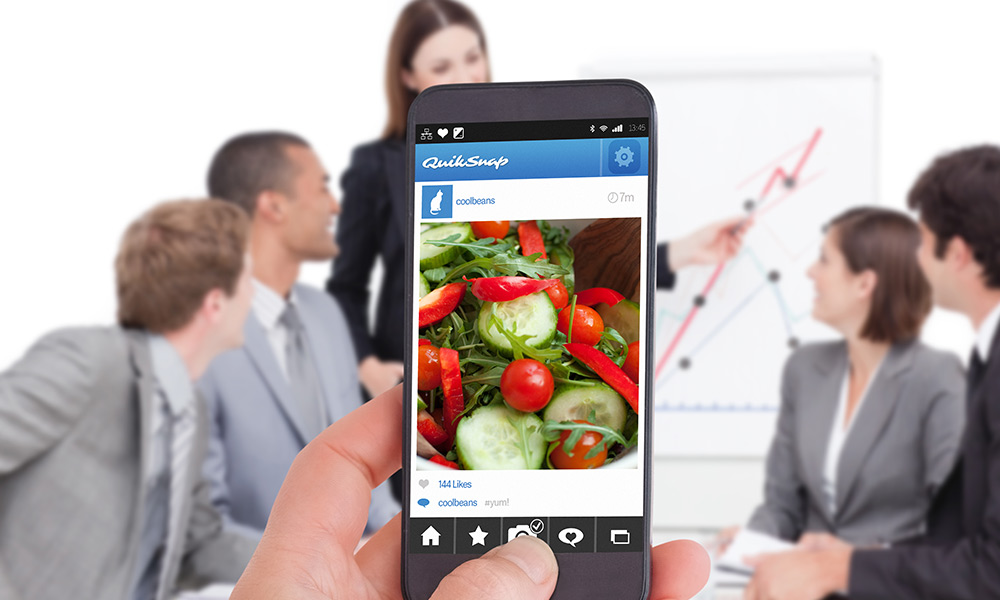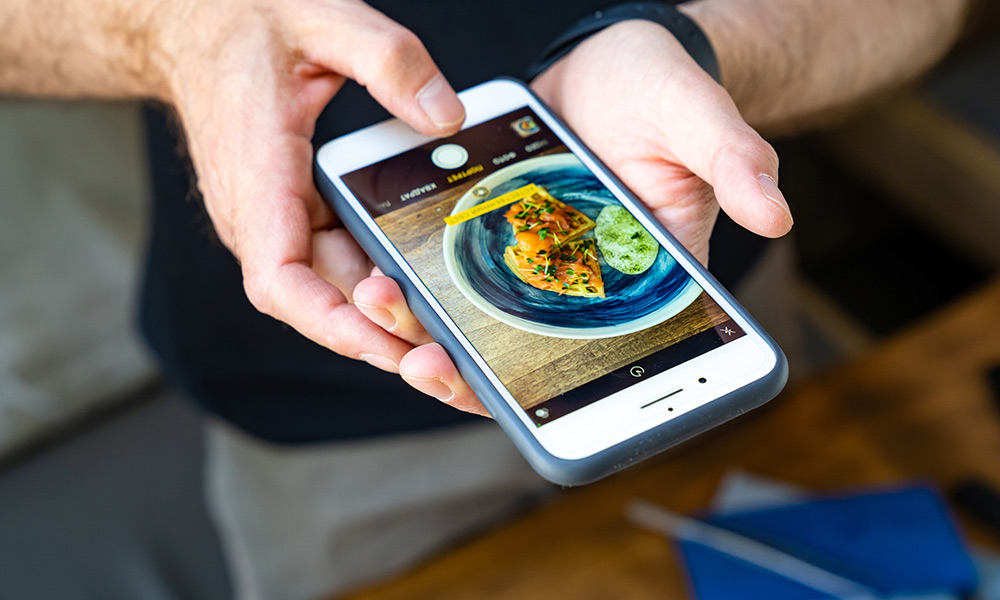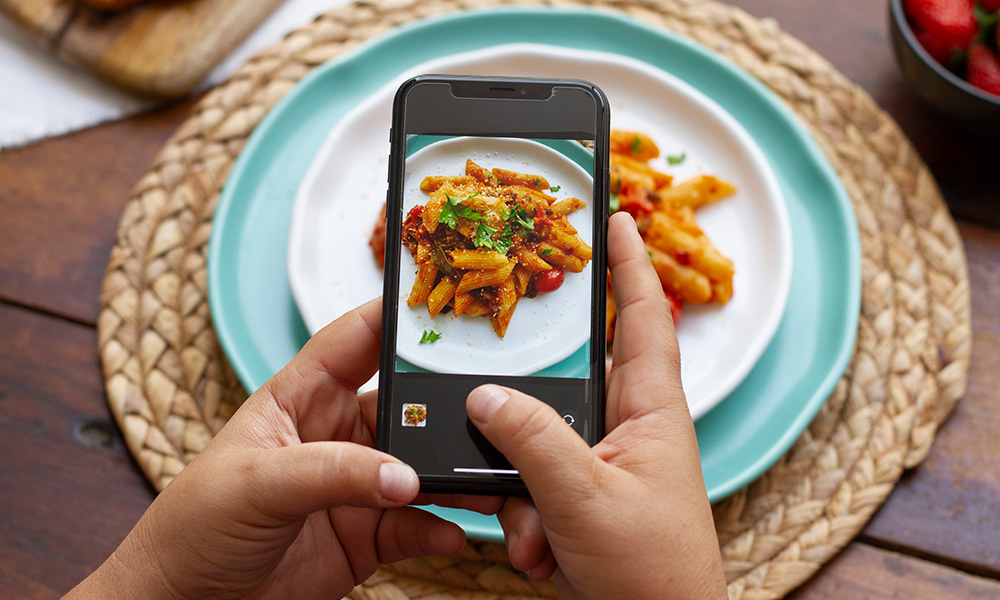Instagram marketing for restaurants is very important these days. Instagram offers restaurants a visually appealing and engaging platform to showcase their brand, attract customers, foster a community, and stay connected with their audience. It allows restaurants to leverage the power of visual content, user-generated content, and influencer collaborations to enhance their online presence and drive foot traffic to their establishments.
Table of Contents
Why Instagram is Important for Restaurants?
Visual Appeal: Instagram is a highly visual platform, and restaurants can showcase their food, drinks, ambience, and overall dining experience through high-quality photos and videos. Sharing enticing images of delicious dishes can attract potential customers and create a desire to visit the restaurant.
Branding and Storytelling: Instagram allows restaurants to establish their brand identity and tell their unique story. By sharing behind-the-scenes glimpses, chef profiles, or the restaurant’s history, they can connect with their audience personally and build a loyal customer base.
Reach and Exposure: Instagram has over 1 billion monthly active users, making it a powerful platform to reach a wide audience. By using hashtags, geotags, and engaging with relevant communities, restaurants can increase their visibility and attract new customers who are looking for dining options in their area.
User-Generated Content: Instagram provides an opportunity for restaurants to leverage user-generated content (UGC). When customers share their dining experiences by posting photos and tagging the restaurant, it acts as social proof and word-of-mouth marketing. Sharing UGC on the restaurant’s official Instagram account can further boost brand credibility and encourage others to visit.
Engagement and Interaction: Instagram allows restaurants to engage directly with their audience through comments, likes, and direct messages. This interaction fosters a sense of community, encourages customer loyalty, and provides a platform for promptly addressing customer queries or concerns.
Influencer Collaborations: Instagram influencers have significant influence over their followers’ choices, and collaborating with relevant influencers can help restaurants reach a broader audience. Influencers can visit the restaurant, share their experiences, and recommend it to their followers, leading to increased brand exposure and potential customers.
Promotions and Special Offers: Restaurants can use Instagram to announce promotions, special menus, discounts, or upcoming events. Instagram Stories, in particular, can be utilized for time-sensitive content and limited-time offers, creating a sense of urgency and encouraging followers to take action.
Market Research and Feedback: Instagram allows restaurants to gather valuable customer feedback through comments, direct messages, or polls. They can gauge customer preferences, interests, and opinions, helping them refine their offerings and improve the overall dining experience.
Organic Instagram Marketing for Restaurants

Organic Instagram marketing for restaurants refers to the use of non-paid strategies and tactics to promote a restaurant’s brand, engage with followers, and increase visibility on the platform.
Remember, organic Instagram marketing takes time and effort to yield results. By consistently creating engaging content, fostering community engagement, and showcasing your restaurant’s unique offerings, you can effectively promote your restaurant, attract new customers, and build a strong online presence.
Here are some effective organic Instagram marketing strategies for restaurants:
- High-Quality Visual Content: Focus on creating visually appealing and high-quality photos and videos of your restaurant’s dishes, drinks, ambiance, and staff. Invest in good lighting, composition, and presentation to make your content stand out.
- Consistent Branding: Develop a consistent brand identity by using a cohesive color scheme, typography, and visual style in your Instagram posts. This helps create recognition and establishes a strong brand presence.
- Engaging Captions: Write engaging and informative captions that complement your visual content. Share stories, descriptions, or interesting facts about your dishes, ingredients, or the restaurant itself. Encourage followers to engage by asking questions or inviting them to tag their friends.
- Hashtags: Utilize relevant and popular hashtags in your posts to increase discoverability. Research industry-specific and location-based hashtags that your target audience is likely to search for when looking for dining options.
- Geotagging: Geotag your restaurant location in your posts to target local customers and increase visibility among users searching for nearby restaurants. This can also attract tourists or people looking for dining recommendations in your area.
- User-Generated Content (UGC): Encourage your customers to share their dining experiences by tagging your restaurant and using a branded hashtag. Repost and give credit to user-generated content, as it adds authenticity and social proof to your Instagram profile.
- Engage with Followers: Take the time to respond to comments, direct messages, and mentions from your followers. Engage in conversations, answer questions, and show appreciation for their support. This helps build a sense of community and fosters customer loyalty.
- Instagram Stories: Utilize Instagram Stories to share behind-the-scenes moments, special promotions, limited-time offers, or live events. Stories provide a sense of urgency and allow for more spontaneous and informal content that resonates with your audience.
- Collaborations and Partnerships: Collaborate with local influencers, food bloggers, or complementary businesses to create mutually beneficial partnerships. They can visit your restaurant, share their experiences, and reach their audience, providing you with additional exposure.
- Consistent Posting Schedule: Maintain a regular posting schedule to stay top of mind with your followers. Consistency is key in building engagement and keeping your audience interested in your content.
- Cross-Promotion: Promote your Instagram account on other marketing channels, such as your website, email newsletters, or other social media platforms. Encourage customers to follow you on Instagram by providing incentives like exclusive offers or contests.
Establishing a strong Instagram profile for Restaurant

To establish a strong Instagram profile for your restaurant, follow these steps:
- Optimize Your Profile:
Choose a username that is easy to remember and represents your restaurant.
Write a compelling and concise bio that highlights your restaurant’s unique selling points, such as cuisine, ambiance, or special offerings.
Add a link to your website or reservation page to drive traffic.
- Use High-Quality Visuals:
Capture high-quality, appetizing images of your food, drinks, and restaurant ambiance.
Ensure your photos are well-lit, well-composed, and visually appealing.
Consider investing in professional photography or using photo editing tools to enhance the visual appeal.
- Showcase Your Signature Dishes:
Feature your most popular or unique dishes prominently in your Instagram feed.
Highlight the key ingredients, preparation methods, and any special features that make them stand out.
Rotate your featured dishes regularly to keep your content fresh.
- Consistent Branding:
Develop a consistent visual theme and aesthetic for your Instagram feed.
Use a consistent color palette, filters, and editing style to create a cohesive look.
Incorporate your logo or other branding elements into your content to reinforce your brand identity.
- Engaging Captions:
Write engaging and informative captions that complement your visuals.
Share interesting stories, background information, or anecdotes about your dishes, ingredients, or restaurant history.
Encourage user engagement by asking questions or inviting followers to share their experiences.
- Utilize Instagram Features:
Experiment with different Instagram features like Stories, Reels, or IGTV to showcase your restaurant in different formats.
Use Stories to share behind-the-scenes content, limited-time offers, or live updates from your restaurant.
Create engaging and entertaining Reels to showcase your food preparation process, chef’s skills, or dining experience.
- Encourage User-Generated Content:
Encourage your customers to tag your restaurant and use a branded hashtag when posting about their dining experiences.
Regularly monitor and engage with user-generated content by liking, commenting, and reposting it with proper credit.
Consider running contests or promotions that encourage customers to create and share content related to your restaurant.
- Engage with Your Audience:
Respond to comments, direct messages, and mentions in a timely manner.
Show appreciation for customer feedback, answer questions, and address concerns promptly.
Foster a sense of community by engaging in conversations and building relationships with your followers.
- Collaborate with Influencers and Partners:
Partner with local influencers or food bloggers who align with your brand and target audience.
Invite them to experience your restaurant and share their authentic reviews and recommendations with their followers.
Collaborate with complementary businesses for cross-promotion and joint initiatives to expand your reach.
- Analyze and Adapt:
Monitor your Instagram insights and analytics to understand which posts perform well and resonate with your audience.
Adjust your content strategy based on the insights gathered to optimize engagement and reach.
Experiment with different types of content, posting times, and strategies to continually improve your profile.
Remember, consistency, quality, and engagement are key to establishing a strong Instagram profile for your restaurant. Regularly update your content, interact with your followers, and showcase your unique offerings to attract and retain a loyal Instagram following.
Captivating food photography for Restaurants Instagram marketing

Captivating food photography is crucial for successful Instagram marketing for restaurants.
Here are some tips to create visually appealing and enticing food photos:
- Lighting:
Natural light is often the best option for food photography. Shoot near a window or outdoors to take advantage of soft, diffused lighting.
Avoid harsh shadows by using a reflector or white foam board to bounce light onto the subject.
- Composition:
Consider the rule of thirds, where you divide your frame into a grid of nine equal parts and place your subject at the intersecting lines or points.
Experiment with different angles and perspectives, such as overhead shots, close-ups, or capturing the food at eye level.
- Styling:
Use props that complement your food and enhance the overall composition. This could include utensils, napkins, fresh ingredients, or decorative elements.
Pay attention to color contrasts and textures to create visually interesting compositions.
- Plating:
Present the food in an appealing and appetizing way. Focus on neatness, symmetry, and the arrangement of elements on the plate.
Consider the balance of colors and textures to make the dish visually appealing.
- Depth of Field:
Play with depth of field by adjusting your aperture settings. A shallow depth of field (low f-number) can create a pleasing blurred background, drawing attention to the main subject.
- Editing:
Use photo editing software or apps to enhance your food photos. Adjust brightness, contrast, and saturation to make the colors pop.
Be cautious not to over-edit, as it can make the image look unnatural.
- Details and Close-ups:
Zoom in on details such as the texture of the food, drips, or garnishes to add visual interest.
Close-up shots can evoke cravings and create a sense of intimacy with the food.
- Storytelling:
Incorporate storytelling elements in your food photography. Show the ingredients, the cooking process, or the chef’s hands to give viewers a behind-the-scenes experience.
- Props and Backgrounds:
Experiment with different backgrounds and textures to create variety in your photos. Wooden tables, marble surfaces, or rustic backdrops can add character to your shots.
Use props that reflect your restaurant’s style and cuisine. For example, if you serve Italian food, incorporate traditional Italian elements like olive oil bottles or wine glasses.
- Consistency:
Maintain a consistent style and aesthetic throughout your food photos to create a cohesive and recognizable brand identity.
Consider creating a signature look by using consistent color tones, filters, or a specific editing style.
Remember, practice and experimentation are key to improving your food photography skills. Pay attention to the details, be patient, and strive to capture the essence and appeal of your dishes in a visually captivating way.
Styling and editing tips for Restaurants Instagram Marketing

Here are some styling and editing tips to enhance your food photography for Instagram:
- Styling Tips:
Choose the Right Props: Select props that complement the style and theme of your restaurant. Consider using utensils, linens, plates, bowls, or ingredients that add visual interest and context to the dish.
- Consider the Background:
Use backgrounds and surfaces that enhance the presentation of your food. Wooden tables, marble slabs, rustic boards, or clean, minimalistic backgrounds can provide an appealing backdrop for your dishes.
- Use Fresh Ingredients:
Incorporate fresh herbs, vibrant vegetables, or colorful fruits as garnishes or side elements in your composition. They can add a pop of color and freshness to your food photos.
- Play with Textures:
Experiment with different textures to create visual interest. This can include using textured plates, rough or smooth surfaces, or adding garnishes with varying textures to enhance the overall composition.
- Consider the Rule of Odds:
When arranging elements in your composition, odd numbers of items often create a more visually pleasing and balanced image. Consider arranging three or five items instead of even numbers.
- Show Action and Movement:
Capture dynamic shots that show action or movement, such as pouring sauces, cutting through a cake, or a fork lifting a bite. This can add energy and excitement to your photos.
- Editing Tips:
Adjust Exposure: Use editing tools to adjust the exposure and brightness of your photo. Enhance the highlights and shadows to bring out the details in both the food and the background.
- Enhance Colors:
Use selective color adjustments to make the colors in your food pop. Adjust the saturation, vibrance, or individual color channels to make the dish look more appetizing.
- Fine-Tune Contrast:
Adjust the contrast to create depth and make the different elements of your photo stand out. Be careful not to overdo it, as excessive contrast can make the image appear harsh or unrealistic.
- Sharpen and Refine Details:
Apply selective sharpening to enhance the details in your food. Use a light touch to avoid introducing noise or artifacts.
- Crop and Straighten:
Crop your photos to remove any distractions or unnecessary elements. Consider straightening the image if the horizon or the main subject appears tilted.
- Experiment with Filters:
Experiment with filters or preset editing options to achieve a consistent style and aesthetic for your Instagram feed. However, ensure that the filter enhances the photo without overpowering the natural look of the food.
- Maintain Natural Colors:
While editing can enhance the visual appeal of your photos, be mindful not to alter the colors of the food excessively. Maintain the natural colors and tones to keep the dish authentic and appetizing.
Remember, the goal of editing is to enhance your food photos while maintaining a realistic representation of the dish. Find a style that aligns with your restaurant’s brand and captures the essence of your cuisine. Consistency in styling and editing can help create a cohesive and visually appealing Instagram profile for your restaurant.
Hashtag Strategy for Restaurant Instagram Marketing

Developing a thoughtful hashtag strategy is important for Instagram marketing for restaurants.
Here are some tips to create an effective hashtag strategy:
- Research Relevant Hashtags: Explore popular and relevant hashtags within the food and restaurant industry. Look for hashtags related to cuisine types, specific dishes, ingredients, food trends, or local hashtags for your city or region. Use tools like Instagram’s search feature or external hashtag research tools to discover trending and popular hashtags.
- Mix Popular and Niche Hashtags: Include a combination of popular hashtags with a high volume of posts and niche hashtags with a smaller but engaged audience. Popular hashtags can help increase your reach, while niche hashtags can help you target a specific audience interested in your cuisine or location.
- Location-Based Hashtags: Include location-specific hashtags to target local customers. Use hashtags related to your city, neighborhood, or popular landmarks to attract people looking for dining options in your area. This can help drive foot traffic to your restaurant.
- Branded Hashtags: Create a unique branded hashtag for your restaurant. Encourage your customers to use this hashtag when posting about their dining experiences at your establishment. This helps generate user-generated content and builds a community around your brand.
- Trending Hashtags: Stay up-to-date with current food and restaurant trends. Incorporate trending hashtags related to food events, holidays, or popular food challenges to tap into the larger conversations happening on Instagram.
- Hashtags for Special Offers or Promotions: Use specific hashtags for promotions, special events, or limited-time offers. This helps create a sense of urgency and encourages users to engage with your content or visit your restaurant.
- Hashtags in Different Languages: If your restaurant serves cuisine from a specific culture or country, consider including relevant hashtags in that language. This can help you reach a wider audience and attract individuals interested in that particular cuisine.
- Hashtags in Stories and Captions: Don’t limit hashtags to just your posts’ captions. Incorporate hashtags in your Instagram Stories, as well. You can add text or sticker-based hashtags to increase visibility and engagement.
- Engage with Hashtag Communities: Follow and engage with popular or niche hashtags related to the food and restaurant industry. Like and comment on posts using these hashtags to interact with potential customers, influencers, or food enthusiasts.
- Monitor and Analyze Hashtag Performance: Keep track of which hashtags are generating the most engagement and reach for your restaurant. Use Instagram insights or external analytics tools to measure the effectiveness of different hashtags. Adjust your strategy based on the performance data to optimize your reach and engagement.
Remember, using relevant and targeted hashtags can help your restaurant gain visibility, reach a wider audience, and connect with potential customers. Regularly refresh and update your hashtag strategy to align with current trends and maximize the impact of your Instagram marketing efforts.
Engaging with Followers for Better Restaurant Instagram Marketing

Engaging with your followers is essential for better Instagram marketing for restaurants.
Here are some tips to effectively engage with your audience on Instagram:
- Respond to Comments: Take the time to respond to comments on your posts. Show appreciation for positive comments, answer questions, and address any concerns or feedback. Engaging in conversations with your followers helps build a sense of community and fosters customer loyalty.
- Like and Reply to Direct Messages: Regularly check your direct messages and respond promptly. Be attentive and provide helpful information or assistance. Direct messages offer a more personal and direct form of communication, allowing you to build stronger connections with your followers.
- Follow and Engage with Your Followers: Show support for your followers by following their accounts and engaging with their content. Like and comment on their posts, especially when they feature your restaurant or dishes. This gesture demonstrates that you value their support and helps strengthen the relationship.
- Repost User-Generated Content: Encourage your followers to create and share content featuring your restaurant or dishes. Repost their content on your Instagram feed or Stories, giving proper credit. This not only shows appreciation for your customers but also serves as social proof and encourages others to share their experiences as well.
- Host Contests and Giveaways: Organize contests or giveaways that require user participation. This could involve tagging friends, sharing their favorite dish, or using a branded hashtag. Engage with participants by liking and commenting on their entries. This strategy increases engagement and expands the reach of your Instagram account.
- Ask Questions and Encourage Feedback: Use your captions or Instagram Stories to ask questions and encourage your followers to share their opinions or experiences. This sparks conversation and provides valuable insights that can help improve your restaurant’s offerings.
- Collaborate with Influencers and Micro-Influencers: Partner with influencers or micro-influencers who align with your restaurant’s brand. Allow them to experience your restaurant and share their genuine reviews and recommendations with their followers. Engage with their posts and show appreciation for their support.
- Show Behind-the-Scenes Content: Share behind-the-scenes glimpses of your restaurant’s operations, food preparation, or events. This gives your followers an exclusive look into your restaurant and creates a sense of exclusivity and excitement.
- Respond to Mentions and Tags: Keep track of mentions and tags of your restaurant on Instagram. Like, comment, or repost content that features your restaurant or dishes. It’s a great way to acknowledge and appreciate your customers’ support while expanding your reach to their followers.
- Monitor Brand Mentions: Regularly search for brand mentions and hashtags related to your restaurant. Engage with posts that mention your restaurant positively or require your response. This demonstrates your commitment to customer satisfaction and strengthens your online reputation.
Remember, authenticity and genuine engagement are key. Take the time to listen, respond, and show appreciation for your followers’ support. By fostering meaningful connections and building a community on Instagram, you can strengthen your restaurant’s brand, attract new customers, and encourage repeat visits.
Paid Instagram Marketing for Restaurants
Paid Instagram marketing can be an effective strategy for restaurants to reach a larger audience, increase brand awareness, and drive more customers to their establishments.
Here are some tips for running paid Instagram marketing campaigns:
- Set Clear Objectives: Define your goals for the campaign. Are you looking to increase brand awareness, drive traffic to your website or reservation page, promote a specific offer or event, or generate more bookings? Clearly outlining your objectives will help you structure your campaign effectively.
- Define Your Target Audience: Identify your target audience based on demographics, interests, location, and behavior. This will ensure that your ads are shown to the right people who are most likely to be interested in your restaurant.
- Choose Ad Formats: Instagram offers various ad formats to choose from, including photo ads, video ads, carousel ads (multiple images or videos in a single ad), Stories ads, and Explore ads. Select the format that best suits your campaign goals and creative assets.
- Compelling Visuals and Copy: Create visually appealing and eye-catching ad content that showcases your restaurant, food, or special offers. Use high-quality images or videos and craft compelling ad copy that captures attention and entices viewers to take action.
- Call-to-Action (CTA): Include a clear and compelling call-to-action in your ad. This can be “Book Now,” “Order Online,” “Reserve a Table,” or any other relevant action that you want viewers to take. Make it easy for users to engage with your restaurant directly from the ad.
- Targeting Options: Utilize Instagram’s targeting options to narrow down your audience and reach the most relevant users. You can target based on location, interests, behaviors, demographics, or even target users who have interacted with your Instagram page or website in the past.
- Budget and Bidding: Set a budget for your campaign and choose the bidding strategy that aligns with your objectives. Instagram offers options such as daily budgeting or lifetime budgeting. Monitor your campaign’s performance and adjust your budget and bidding strategy as needed.
- Ad Scheduling: Consider scheduling your ads to run during peak times when your target audience is most active on Instagram. This can help maximize the visibility and engagement of your ads.
- Track and Measure Results: Use Instagram’s built-in analytics tools or third-party tracking tools to monitor the performance of your ads. Measure metrics such as impressions, reach, clicks, conversions, and return on investment (ROI). Analyze the data to optimize your campaign and make informed decisions for future marketing efforts.
- Experiment and Iterate: Don’t be afraid to experiment with different ad variations, targeting options, and messaging. Test different creatives, ad formats, and audience segments to identify what resonates best with your target audience. Continually optimize your campaign based on insights and data.
Remember, paid Instagram marketing for Restaurants can be a valuable addition to your overall Restaurant Social Media Marketing Strategy, but it’s important to align your campaigns with your goals, target the right audience, and continuously monitor and optimize your ads for the best results.
Types of Instagram Ads For Restaurants
Brand Awareness Ads for Restaurant Instagram Marketing
How to set up Brand Awareness Ads for Restaurants in Instagram
To set up brand awareness ads for your restaurant on Instagram, follow these steps:
- Set up a Business Profile: Ensure that you have a business profile on Instagram. If you don’t have one, convert your existing personal profile to a business profile or create a new one. A business profile gives you access to advertising features and analytics.
- Install the Facebook Pixel: Install the Facebook Pixel on your website. The Facebook Pixel allows you to track and measure the effectiveness of your Instagram ads, as well as retarget users who have interacted with your website.
- Link Instagram to Facebook Ads Manager: Connect your Instagram account to Facebook Ads Manager. This will allow you to create and manage your Instagram ads directly from the Ads Manager platform.
- Define Your Campaign Objective: In Ads Manager, select the objective of your campaign as “Brand Awareness.” This objective is designed to increase the visibility and reach of your brand.
- Target Your Audience: Define your target audience based on demographics, interests, behaviors, and location. Instagram offers a range of targeting options to ensure your ads reach the most relevant audience for your restaurant.
- Set Your Budget and Schedule: Determine your budget for the campaign and set the duration or schedule for your ads. You can choose to set a daily or lifetime budget, and specify the start and end dates of your campaign.
- Choose Ad Placements: Select Instagram as the placement for your ads. You can choose to display your ads in users’ feeds, Stories, or both. Consider experimenting with different ad placements to reach a wider audience.
- Design Compelling Ad Creative: Create visually appealing images or videos that showcase your restaurant, dishes, ambiance, or unique offerings. Use captivating visuals and engaging copy that align with your brand message and grab viewers’ attention.
- Craft Ad Copy: Write compelling and concise ad copy that supports your visual content and conveys your brand message effectively. Use clear and engaging language to communicate the unique aspects of your restaurant.
- Review and Launch Your Campaign: Review your ad settings, targeting, budget, and creative content to ensure everything is set up correctly. Once you’re satisfied, launch your brand awareness campaign and monitor its performance.
- Monitor and Optimize: Regularly check the performance of your brand awareness ads using Facebook Ads Manager. Monitor metrics such as reach, impressions, and engagement. Use this data to make informed decisions and optimize your campaign as needed.
- Test and Iterate: Experiment with different ad variations, targeting options, and messaging to identify what resonates best with your target audience. Test different visuals, ad formats, or audience segments to optimize the performance of your brand awareness ads.
Remember to keep an eye on your campaign’s performance and make adjustments as necessary. Continuously refine your targeting, messaging, and creative elements to ensure your brand awareness ads effectively promote your restaurant and reach the right audience on Instagram.
Store Visits Ads for Restaurant Instagram Marketing
How to set up Store Visits for Restaurants Instagram Marketing?
Setting up Store Visits for restaurant Instagram marketing involves utilizing Instagram’s store visit ad objective to drive foot traffic to your physical location.
Here’s a step-by-step guide to setting up Store Visits for your restaurant on Instagram:
- Verify Your Business: Ensure that your restaurant’s Instagram account is linked to a verified Facebook Business Page. Verification adds credibility to your business and enables you to access advanced advertising features.
- Access Facebook Ads Manager: Log in to your Facebook Ads Manager account, which is where you’ll create and manage your Instagram ads.
- Define Your Campaign Objective: In Ads Manager, select the objective of your campaign as “Store Visits.” This objective is specifically designed to drive offline conversions and foot traffic to your physical location.
- Set Up Ad Set: Create a new ad set within your campaign. In the ad set settings, you’ll define your target audience, budget, and schedule. Make sure to set the location targeting to focus on the areas where your restaurant is located or where you want to attract customers.
- Choose Ad Placements: Select Instagram as one of the ad placements for your campaign. This ensures that your ads are displayed to Instagram users who are most likely to visit your restaurant.
- Design Engaging Ad Creative: Create visually appealing ad content that showcases your restaurant’s ambiance, dishes, or special offers. Use high-quality images or videos, compelling copy, and a clear call-to-action to encourage users to visit your establishment.
- Set Up Location Extensions: Enable location extensions in your Instagram ads. This feature adds your restaurant’s address and directions directly into your ads, making it easier for users to find your location.
- Implement Facebook Pixel: Install the Facebook Pixel on your website if you haven’t done so already. The pixel helps track and measure the effectiveness of your ads, including store visits and offline conversions.
- Monitor and Optimize: Once your Store Visits campaign is live, regularly monitor its performance through Ads Manager. Analyze key metrics such as store visits, impressions, reach, and engagement. Adjust your targeting, creative, and budget as necessary to optimize your results.
- Leverage Instagram Insights: Utilize Instagram’s built-in analytics tool, Instagram Insights, to gain insights into the performance of your organic Instagram posts. Understand which posts generate the most engagement and tailor your content strategy accordingly.
- Encourage Customer Engagement: Engage with customers who visit your restaurant as a result of your Instagram marketing efforts. Respond to comments, direct messages, and reviews, showing appreciation and fostering a positive relationship with your audience.
By setting up Store Visits campaigns on Instagram, you can effectively drive more foot traffic to your restaurant and increase in-store conversions. Continuously analyze your campaign’s performance, make adjustments as needed, and engage with your customers to maximize the impact of your Instagram marketing efforts.
Engagement Ads for Restaurant Instagram Marketing
How to run Engagement Ads to increase Instagram followers for restaurants?
Running engagement ads on Instagram can be an effective way to increase your restaurant’s Instagram followers.
Here’s a step-by-step guide to setting up engagement ads for your restaurant:
- Set up a Business Profile: Ensure that your restaurant’s Instagram account is set up as a business profile. This will give you access to advertising features and analytics.
- Access Facebook Ads Manager: Log in to your Facebook Ads Manager account, which is where you’ll create and manage your Instagram ads.
- Define Your Campaign Objective: In Ads Manager, select the objective of your campaign as “Engagement.” This objective is designed to increase interactions with your ads, such as likes, comments, shares, and follows.
- Set Up Ad Set: Create a new ad set within your campaign. Define your target audience based on demographics, interests, and behaviors. Consider targeting people in your local area or those who have shown an interest in similar restaurants or cuisines.
- Choose Ad Placements: Select Instagram as one of the ad placements for your campaign. This ensures that your engagement ads will be displayed to Instagram users.
- Design Compelling Ad Creative: Create visually appealing ad content that encourages users to engage with your restaurant’s Instagram profile. Use eye-catching images or videos, captivating copy, and a clear call-to-action that encourages viewers to follow your account.
- Leverage Interactive Content: Consider using interactive content formats, such as polls, quizzes, or contests, to drive engagement and entice users to follow your restaurant’s Instagram page.
- Utilize Hashtags: Include relevant and popular hashtags in your ad copy to increase the visibility of your ads and reach users who are interested in similar content. Research and use hashtags that are commonly used within the food and restaurant community.
- Monitor and Optimize: Once your engagement ad campaign is live, regularly monitor its performance through Ads Manager. Analyze key metrics such as engagement rate, follows, reach, and impressions. Adjust your targeting, creative, and budget as necessary to optimize your results.
- Engage with New Followers: When users follow your restaurant’s Instagram account as a result of the engagement ads, make sure to engage with them by responding to comments, direct messages, and engaging with their content. Show appreciation for their support and build a positive relationship.
- Track Follower Growth: Keep track of your follower growth over time to assess the effectiveness of your engagement ads. Analyze trends and patterns to understand what resonates with your target audience and adjust your strategies accordingly.
Remember that engagement ads are designed to increase interactions and followers, but building a loyal and engaged community takes time and consistent effort. Combine your ad campaigns with high-quality content, regular posting, and authentic engagement to foster a strong and active Instagram following for your restaurant.
More Types of Instagram Ads Campaign for Restaurants
There are several types of Instagram ads that restaurants can leverage to promote their business and engage with their target audience.
Here are some of the most common types of Instagram ads:
- Photo Ads: These are standard single-image ads that appear in users’ Instagram feeds. Restaurants can use high-quality photos of their dishes, ambiance, or special promotions to capture attention and entice viewers to visit their establishment.
- Video Ads: Video ads allow restaurants to tell a more immersive story and engage viewers with motion and sound. It can be used to showcase the cooking process, highlight the dining experience, or promote events or special offers.
- Carousel Ads: Carousel ads allow you to showcase multiple images or videos in a single ad. Restaurants can use this format to showcase different dishes, highlight various menu items, or provide a visual journey of the dining experience.
- Stories Ads: Instagram Stories ads appear between users’ Stories and provide a full-screen, immersive experience. Restaurants can use this format to share behind-the-scenes footage, promote limited-time offers, or give a sneak peek into special events.
- Collection Ads: Collection ads allow restaurants to showcase multiple products or menu items in a single ad. When users tap on the ad, they are taken to a full-screen instant experience where they can explore more details about the items and easily navigate to the restaurant’s website or reservation page.
- Explore Ads: Explore ads are shown to users when they browse through the Explore tab on Instagram. These ads can help restaurants reach a wider audience and target users based on their interests. Restaurants can use this format to showcase their unique cuisine, highlight popular dishes, or promote special events.
- IGTV Ads: IGTV (Instagram TV) ads are ads that appear when users are watching long-form video content on IGTV. Restaurants can create engaging videos such as cooking tutorials, chef interviews, or behind-the-scenes content to capture viewers’ attention and promote their brand.
- Branded Content Ads: Branded content ads allow restaurants to partner with influencers or content creators to promote their brand. These ads appear as sponsored content in users’ feeds and can help restaurants reach a larger audience and leverage the influencer’s credibility and following.
It’s important for restaurants to choose the ad format that aligns with their campaign goals, creative assets, and target audience. Experimenting with different ad types can help you find the most effective approach to engage with your audience and drive results for your restaurant.
Hiring an Instagram marketing agency vs in-house Instagram Marketing for Restaurants
Deciding between hiring an Instagram marketing agency or managing your Instagram marketing in-house for your restaurant depends on various factors. Here are some considerations to help you make an informed decision:
Hiring an Instagram Marketing Agency for Restaurant
- Expertise and Experience: An agency specializing in Instagram marketing brings expertise and experience in running successful campaigns. They are knowledgeable about the platform’s best practices, algorithms, and strategies to maximize your restaurant’s presence and engagement.
- Time and Resources: Outsourcing your Instagram marketing to an agency allows you to focus on running your restaurant while professionals handle your social media efforts. Agencies have the necessary resources, tools, and team members dedicated to managing your campaigns effectively.
- Creative Direction: An agency can provide fresh and creative ideas for your Instagram content, helping your restaurant stand out from competitors. They can offer insights and strategies to create compelling visuals, engaging captions, and a consistent brand voice.
- Industry Insights: Instagram marketing agencies often work with various clients in the restaurant industry, which gives them a deep understanding of the market, trends, and customer behaviors. They can leverage this knowledge to tailor strategies specifically for your restaurant’s target audience.
Managing Restaurant Instagram Marketing In-House
- Cost Efficiency: Managing your Instagram marketing in-house can be more cost-effective, especially for smaller restaurants with limited budgets. You have control over the expenses and can allocate resources based on your needs.
- Brand Control and Alignment: Handling Instagram marketing internally allows you to maintain complete control over your brand’s messaging, tone, and visuals. You have a direct say in the content creation process, ensuring it aligns with your restaurant’s unique identity.
- Immediate Response: In-house management enables quick responses to customer inquiries, comments, and feedback. You have direct access to your Instagram account and can promptly engage with your audience, strengthening customer relationships.
- Authenticity and Personalization: Managing your restaurant’s Instagram marketing internally allows you to showcase the authentic personality and behind-the-scenes aspects of your establishment. You have a firsthand understanding of your restaurant’s culture, staff, and customers, which can be reflected in your content.
- Flexibility and Agility: With in-house management, you can quickly adapt to changing circumstances, such as promotions, events, or menu updates. You have the freedom to experiment with content formats and posting schedules based on real-time feedback.
Ultimately, the choice between hiring an Instagram marketing agency or managing it in-house depends on your restaurant’s specific needs, resources, and objectives. It can also be a combination of both, where you collaborate with an agency for strategic guidance and support while handling day-to-day management internally. Consider factors such as budget, expertise, time availability, and the level of control you desire to make the best decision for your restaurant’s Instagram marketing.
Best Practices for Instagram Marketing for Restaurants
To make the most of your restaurant’s Instagram marketing efforts, here are some best practices to consider:
- High-Quality Visual Content: Instagram is a visual platform, so focus on creating high-quality, visually appealing content. Use high-resolution images and videos that showcase your food, ambiance, and overall dining experience. Pay attention to composition, lighting, and colors to make your posts visually captivating.
- Consistent Branding: Maintain a consistent brand identity across your Instagram profile. Use consistent colors, fonts, and visual elements that reflect your restaurant’s brand. This helps create a cohesive and recognizable presence on Instagram.
- Engaging Captions: Craft compelling captions that complement your visuals and tell a story. Use a conversational tone, include relevant hashtags, and add a call-to-action to encourage engagement from your audience. Captions can provide context, convey your brand’s personality, and spark conversations.
- Utilize Instagram Stories: Take advantage of Instagram Stories to share behind-the-scenes content, limited-time offers, promotions, and daily specials. Stories offer a more casual and authentic way to connect with your audience. Experiment with features like polls, questions, and interactive stickers to engage your followers.
- User-Generated Content (UGC): Encourage your customers to generate content about their dining experiences and share it with your branded hashtag. Reposting UGC not only builds a sense of community but also provides social proof and authentic recommendations from satisfied customers.
- Influencer Partnerships: Collaborate with relevant influencers or local food bloggers who have a substantial following and a niche audience aligned with your target market. Partnering with influencers can help increase your reach, visibility, and credibility.
- Engage with Your Audience: Respond to comments, direct messages, and mentions promptly. Engaging with your audience builds a sense of community and shows that you value their feedback and support. Like and comment on posts from customers who tag or mention your restaurant.
- Utilize Instagram Ads: Instagram offers advertising options that allow you to target specific demographics, interests, and locations. Experiment with Instagram ads to increase brand awareness, drive traffic to your website or reservation platform, and promote special offers.
- Collaborate with Local Businesses: Forge partnerships with complementary local businesses, such as breweries, wineries, or food suppliers. Collaborative promotions and cross-posting can help expand your reach to new audiences and create mutually beneficial relationships.
- Track and Analyze Metrics: Regularly monitor the performance of your Instagram posts using the built-in Instagram Insights or third-party analytics tools. Analyze your key metrics, such as engagement rate, reach, and follower growth, to understand what content resonates best with your audience and make data-driven decisions for future campaigns.
Remember, Instagram marketing is an ongoing process, so it’s important to experiment, learn from your audience’s preferences, and adapt your strategies accordingly.
Restaurant Instagram Marketing And Promotion KPIs
When it comes to Instagram marketing for restaurants, there are several key performance indicators (KPIs) you can track to measure the effectiveness of your efforts.
Here are some common KPIs for restaurant Instagram marketing:
- Follower Growth: This KPI measures the number of new followers your Instagram account gains over a specific period. It indicates the reach and appeal of your content and the overall growth of your audience.
- Engagement Rate: Engagement rate calculates the level of interaction and interest your content generates from your followers. It is typically measured as the percentage of likes, comments, and shares relative to the total number of followers. A higher engagement rate signifies a more engaged audience.
- Reach and Impressions: Reach refers to the number of unique users who see your Instagram posts, while impressions represent the total number of times your posts are viewed. Monitoring these metrics helps you gauge the visibility and exposure of your content.
- Click-through Rate (CTR): If you have a link in your Instagram bio or use the swipe-up feature in Instagram Stories (available to accounts with 10,000 or more followers), CTR measures the percentage of users who click on those links. It indicates the effectiveness of your call-to-action and the level of interest in your offerings.
- Hashtag Performance: Tracking the performance of specific hashtags used in your posts can provide insights into their effectiveness. You can measure the number of times your posts appeared in the “Top Posts” section for a particular hashtag or the engagement generated by posts featuring those hashtags.
- User-Generated Content (UGC): Encouraging customers to create and share content related to your restaurant can be a valuable marketing strategy. Monitoring the number of UGC posts, as well as the engagement and reach of those posts, helps you assess the success of your UGC campaigns.
- Conversion Rate: If your Instagram marketing includes specific goals, such as driving reservations or online orders, tracking the conversion rate is crucial. It measures the percentage of Instagram users who take the desired action, such as making a reservation or placing an order, after viewing your content.
Remember, these KPIs should align with your overall marketing goals and be tracked regularly to assess your Instagram marketing strategy’s effectiveness. It’s essential to set benchmarks, analyze trends, and make data-driven decisions to optimize your efforts and achieve better results.
How much should I invest in Restaurant Instagram marketing?
The amount you should invest in restaurant Instagram marketing depends on several factors, including your overall marketing budget, business goals, target audience, competition, and the size of your restaurant.
Here are some considerations to help determine your investment:
- Budget Allocation: Allocate a portion of your marketing budget specifically for Instagram marketing. The percentage can vary based on your overall marketing goals and the importance of Instagram in your marketing strategy.
- Business Goals: Consider your specific business goals for Instagram marketing. Are you looking to increase brand awareness, drive foot traffic, boost online orders, or promote special events? The more ambitious your goals, the more resources you may need to allocate to achieve them.
- Target Audience: Understand your target audience and their behavior on Instagram. If your target demographic is active on the platform and Instagram plays a significant role in their decision-making process, it may be worthwhile to invest more in reaching and engaging with them.
- Competitive Landscape: Evaluate the level of competition on Instagram within your restaurant’s niche. If your competitors are actively investing in Instagram marketing and gaining traction, it may be necessary to allocate a competitive budget to stay relevant and capture your audience’s attention.
- Ad Costs and ROI: Consider the costs associated with running Instagram ads, including ad creative production, ad placement, and targeting. Track the performance of your campaigns and measure the return on investment (ROI) to assess the effectiveness of your Instagram marketing efforts.
- Testing and Optimization: Budget for testing different strategies, ad formats, and targeting options. It’s important to continuously optimize your Instagram marketing campaigns based on data-driven insights. Testing allows you to refine your approach and allocate a budget more efficiently.
- Content Production: Allocate resources for creating high-quality content, including professional photography or videography if needed. Visual content plays a crucial role in attracting and engaging Instagram users, so investing in visually appealing and captivating content is important.
Remember that there is no one-size-fits-all answer to how much you should invest in Instagram marketing. It’s essential to evaluate your unique circumstances, set realistic goals, monitor your performance, and adjust your investment accordingly. Start with a conservative budget and gradually increase it as you see positive results and gain a better understanding of your audience’s preferences and behaviors on the platform.
how much does Restaurant Instagram marketing cost monthly and yearly?
The cost of restaurant Instagram marketing can vary significantly based on several factors, including the size of your restaurant, your marketing objectives, the level of competition in your market, and the strategies and resources you choose to implement.
Here are some cost considerations for restaurant Instagram marketing:
- Ad Spend: Instagram advertising costs can vary depending on factors such as your target audience, ad placement, competition, and ad format. You have control over your ad spend and can set a daily or lifetime budget for your campaigns. It’s advisable to start with a conservative budget and increase it as you see positive results.
- Content Creation: Budget for creating high-quality visual content, including professional photography, graphic design, or videography. This may involve hiring a photographer or graphic designer or investing in equipment/software for in-house content creation. The cost can vary based on your specific needs and the complexity of the content you want to produce.
- Content Management: Consider the time and resources required to manage and maintain your Instagram account. This includes planning and scheduling posts, engaging with your audience, responding to comments and messages, and monitoring performance. You may allocate internal resources or consider outsourcing social media management, which can involve monthly or yearly fees.
- Influencer Collaborations: Collaborating with influencers or micro-influencers in the food and restaurant niche can help amplify your restaurant’s reach and engagement on Instagram. The cost of influencer collaborations can vary based on the influencer’s reach, engagement rate, and the scope of the collaboration. Some influencers may charge a flat fee, while others may work on a product or meal exchange basis.
- Tools and Software: Consider the cost of social media management tools or analytics software that can help you streamline your Instagram marketing efforts, track performance, and gain insights. There are both free and paid options available, so assess your needs and budget accordingly.
It’s challenging to provide an exact cost range for restaurant Instagram marketing as it depends on the factors mentioned above. However, as a rough estimate, a small to medium-sized restaurant could potentially spend anywhere from a few hundred to a few thousand dollars per month on Instagram marketing. On a yearly basis, this could range from several thousand to tens of thousands of dollars.
It’s essential to evaluate your restaurant’s specific needs, objectives, and budget constraints when determining your Instagram marketing costs. Start with a budget that aligns with your goals, track your performance and ROI, and make adjustments as needed to optimize your marketing efforts within your available resources.
How to control Instagram marketing costs for Restaurants?
Controlling Instagram marketing costs for your restaurant requires careful planning, monitoring, and optimization.
Here are some strategies to help you maintain control over your expenses:
- Set a Budget: Determine a specific budget allocation for your Instagram marketing efforts. This will help you establish a limit on how much you can spend and prevent overspending. Consider factors such as your overall marketing budget, business goals, and the importance of Instagram in your marketing strategy.
- Define Clear Objectives: Clearly define your marketing objectives and key performance indicators (KPIs) upfront. This will allow you to focus your efforts and resources on activities that directly contribute to your goals. By having specific goals in mind, you can make more informed decisions about where to invest your budget.
- Monitor Ad Performance: Regularly monitor the performance of your Instagram ads through the Ads Manager or other analytics tools. Track metrics such as reach, engagement, click-through rates, conversions, and cost per result. Analyze the data to identify which ads are performing well and which ones may need adjustments.
- Optimize Ad Campaigns: Continuously optimize your ad campaigns based on performance data. Identify underperforming ads and make necessary adjustments to improve their effectiveness. This could include refining your targeting, adjusting your ad creative, testing different ad formats, or refining your call-to-action.
- Test and Learn: Implement a testing strategy to understand what works best for your restaurant on Instagram. Test different ad formats, targeting options, creative variations, and messaging to identify the most effective combinations. This iterative approach allows you to optimize your campaigns and allocate your budget more efficiently.
- Ad Scheduling and Frequency: Strategically schedule your ads to reach your target audience at the most opportune times. Analyze your audience insights to understand when they are most active on Instagram and adjust your ad scheduling accordingly. Also, consider the frequency of your ads to avoid oversaturation and wasted spend.
- Targeting Refinement: Continuously refine your audience targeting to ensure your ads are reaching the most relevant and engaged users. Narrow down your targeting parameters based on demographics, interests, behaviors, and location. This helps you avoid spending on audiences that are unlikely to convert.
- Leverage Organic Strategies: Don’t solely rely on paid advertising. Invest time and effort in building an organic following on Instagram through high-quality content, engaging with your audience, and leveraging user-generated content. Organic strategies can help complement your paid efforts and reduce reliance on advertising spend.
- Cost-Effective Content Creation: Optimize your content creation process to be cost-effective. Consider in-house content creation using smartphone photography or collaborate with local photographers or influencers who align with your brand values. Look for opportunities to repurpose content across multiple platforms to maximize its reach and value.
- Regular Performance Evaluation: Conduct regular performance evaluations to assess the overall effectiveness of your Instagram marketing efforts. Analyze the return on investment (ROI) and compare it to your objectives. Adjust your strategies, budget, and tactics as needed based on your findings.
By implementing these strategies, you can maintain control over your Instagram marketing costs for your restaurant. Continuously monitor and optimize your campaigns, test new approaches, and align your spending with your business goals to ensure a cost-effective and impactful Instagram marketing strategy.
Need Restaurants Instagram Marketing Services?
RankON Technologies is a leading social media marketing company. We offers complete Facebook Marketing and Instagram marketing services for all types of businesses. Visit our Facebook Marketing Plans and Instagram marketing packages to know more.
Get in Touch!Check Instagram PackagesRestaurant Instagram Marketing FAQs
The frequency of your posts depends on your audience, content availability, and engagement levels. Generally, posting at least 3-5 times per week is recommended to maintain an active presence. Experiment with different posting frequencies and monitor engagement to find the optimal posting schedule for your restaurant.
Share a variety of content that showcases your restaurant’s personality, food, ambiance, and behind-the-scenes moments. This can include high-quality food photography, videos, customer testimonials, staff features, specials or promotions, user-generated content, and community involvement.
Hashtags are crucial for increasing the visibility of your content and reaching a wider audience. Research relevant hashtags that are popular in the food and restaurant community, and include them in your captions. Use a mix of broad and specific hashtags to target different segments of your audience.
Collaborating with influencers can be a powerful way to expand your reach and engage with new audiences. Look for influencers who align with your restaurant’s values and target demographic. Collaborations can include sponsored posts, takeovers, or hosting influencer events at your restaurant.
Engagement is key to building a loyal following. Respond to comments, direct messages, and mentions promptly. Like and comment on your followers’ posts and engage with their content. Run contests, polls, or Q&A sessions to encourage interaction. Show appreciation for your followers and build genuine connections.
While it’s not mandatory, running paid ads on Instagram can significantly boost your reach, engagement, and conversions. Paid ads allow you to target specific audiences, promote specials or events, and drive traffic to your restaurant. Start with a modest budget and test different ad formats to see what works best for your goals.
Instagram provides insights and analytics within the app for business accounts. Monitor metrics such as follower growth, engagement rate, reach, impressions, and website clicks. Use these insights to evaluate the effectiveness of your strategies and make data-driven decisions.
? Hiring an Instagram marketing agency can be beneficial if you lack the time, expertise, or resources to manage your Instagram marketing in-house. An agency can provide strategic guidance, content creation, advertising management, and analytics. Consider your budget and specific needs before deciding on outsourcing your Instagram marketing.












